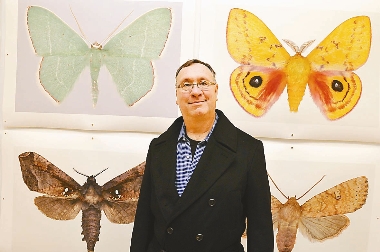|


Diana Cooper’s large installation, “Orange Alert USA,” consists of a mixture of materials, such as paper, acetate, vinyl, felt, neoprene, foam core, corrugated plastic and map pins.
Cooper said the work was inspired by a color-coded security alert system developed, and recently abandoned, by the United States Government in the aftermath of the terrorist attacks of Sept. 11, 2001.
The classification system was meant to convey the level of threat Americans faced by using a color scale ascending from green to blue, then yellow, orange, and red.
“For me it became a catalyst for exploring and experimenting with the relation of color, abstract form, human psychology and images of man-made systems,” said Cooper. “The result is a synthetic, coded, and sometimes amusing landscape of half-recognizable forms, a system signifying many things, or perhaps nothing.”
Born in Connecticut in 1964, Cooper now lives in Brooklyn, New York. She is best known for her large installations that blur distinction between drawing, painting, and sculpture.
Joseph Scheer has a series of digital prints on show entitled “Moths.” These are large, high-resolution scans that bring the structure and beauty of moths to life.
Scheer is a professor of print media and co-director/founder of the Institute for Electronic Arts at the School of Art and Design, Alfred University, New York.
For the past 12 years, he has been using scanning technology to create images of small biological subjects. Working with high-end scanners, he has refined techniques to produce finished prints of phenomenal clarity of up to 2.5 meters in expanse from subjects of only a few millimeters in size.
“My work celebrates the beauty of these creatures and develops an awareness of a world that surrounds us but remains largely invisible,” Scheer said.
Elisabeth Meyer makes small, delicate prints that draw from a range of natural and architectural influences that are personal in nature, but easily translate into compositions in which “meaning must be extracted from the reading of images alone.”
She has two series of intaglio prints — “Apologia and The Quiddity” — in the exhibition.
“Some of the questions I am motivated by include concerns for our collective survival. What is socially productive? Do we invest in excess value? Who exerts power over us? My social epiphany involves questioning the locus of power, also identified as a source of common frustration,” she said.
In “Apologia” and “The Quiddity,” Meyer questions sequential thinking and the logic of repetition, and struggles with the binary realities of engagement and escape, meditation and action, information and nature.
Born in Virginia in 1953, Meyer earned her master’s degree in fine arts from the University of Texas at Austin in 1980.
|

